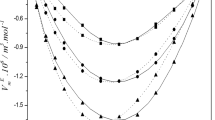Abstract
Quantitative and qualitative parameters are essential for comprehending the intermolecular interactions in binary polar liquids. In this work, complex permittivity and excess dielectric constant of alcohol–water mixture is used for the quantitative and qualitative analysis, respectively. Aqueous solutions of methanol, ethanol, propanol and isopropyl alcohol are considered. The frequency dispersion of permittivity and the intricate structure of these liquids make the analysis a difficult task. A decision tree regression-based machine-learning model is proposed for the prediction of parameters. For quantitative analysis, the dataset is prepared by measuring the complex permittivity of the mixture using dielectric probe kit–N1501A of Keysight Technologies over a frequency range of 0.2–20 GHz at 25°C. For qualitative analysis, available standard equations are modified to calculate the excess dielectric constants in the specified frequency range. The proposed model requires only three input parameters—frequency, volume fraction of alcohol and static dielectric constant of alcohol to make the prediction. Performance comparison of the model with the measured values of complex permittivity shows minimum error. The analysis reveals the effect of the volume fraction of alcohol and frequency on complex permittivity and excess dielectric constant of the mixture. The proposed model is a novel and reliable prediction tool that can be used for both quantitative and qualitative analysis of alcohol–water mixture.










Similar content being viewed by others
References
Mehrotra S C, Kumbharkhane A and Chaudhari A 2017 Binary polar Liquids (Netherlands: Elsevier)
Gregory A P and Clarke R N 2006 IEEE Trans. Diel. Electr. Ins. 13 727
Bao J Z, Swicord M L and Davis C C 1996 J. Chem. Physic. 104 4441
Gregory A P, Clarke R N and Cox M G 2009 Meas. Sci. Technol. 20 75106
Wei Y Z and Sridhar S 1989 Rev. Sci. Instrum. 60 3041
San Millán Castillo R, Morgado E and Goya Esteban R 2020 IEEE Sens. J. 20 4120
Pekel E 2020 Theor. Appl. Climato. 139 1111
Javaid M F, Azam R and Riaz M R 2023 Innov. Infrastruct. Solut. 8 103
Latif S D 2021 Environ. Sci. Pollut. Res. 28 65935
Jumin E, Basaruddin F B, Yusoff Y B M, Latif S D and Ahmed A N 2021 Environ. Sci. Pollut. Res. 28 26571
Genrikhov I E, Djukova E V and Zhuravlev V I 2017 Pattern Recognit. Image Anal. 27 1
Kaushik V and Awasthi N 2023 AI Civ. Eng. 2 2
Taser P Y, Onsal G and Ugurlu O 2022 Bull. Mater. Sci. 46 1
Quinlan J R 1986 Mach. Learn. 1 81
Salim A, Memon M U, Jeong H and Lim S 2020 Sensors 20 4985
Buckingham A D 1953 Aust. J. Chem. 6 93
Cheng J, Peng Y, Li E, Yu C, Zhang Y, Gao Y et al 2022 Rev. Sci. Instrum. 93 104701
Chmielewska A, Żurada M, Klimaszewski K and Bald A 2009 J. Chem. Eng. Data 54 801
Sengwa R J, Sankhla S and Shinyashiki N 2008 J. Solut. Chem. 37 137
Cardona J, Sweatman M B and Lue L 2018 J. Phys. Chem. 122 1505
Navarkhele V V 2016 Int. J. Pharm. Pharm. Sci. 8 102
Kanse K S, Chavan S D, Mali C S, Kumbharkhane A C and Mehrotra S C 2006 Indian J. Phys. 80 265
Mashimo S, Umehara T and Redlin H 1991 J. Chem. Phys. 95 6257
Yang L J, Yang X Q, Huang K M, Shang H and Jia G Z 2010 J. Solution Chem. 39 473
Ghorbanpour T, Gilani A G and Fallahi S 2018 J. Mol. Liq. 260 403
Sato T and Buchner R 2005 J. Mol. Liq. 117 23
Jukic I, Pozar M and Lovrincevic B 2020 Phys. Chem. Chem. Phys. 22 23856
Sudo S, Shinyashiki N, Kitsuki Y and Yagihara S 2002 J. Phys. Chem. A 106 458
Sato T, Chiba A and Nozaki R 2002 J. Mol. Liq. 96 327
Li T, Fan W, Sun J, Yu Y, Zhou X, Xie C et al 2020 J. Raman Spectrosc. 53 1551
Vyshnavi V R and Malik A 2019 Int. J. Recent Res. Asp. 6 16
Acknowledgement
We acknowledge the measurement facility provided by the Center for Research in Electromagnetics and Antennas (CREMA), Department of Electronics, Cochin University of Science and Technology, Kochi, Kerala, India.
Author information
Authors and Affiliations
Corresponding author
Rights and permissions
Springer Nature or its licensor (e.g. a society or other partner) holds exclusive rights to this article under a publishing agreement with the author(s) or other rightsholder(s); author self-archiving of the accepted manuscript version of this article is solely governed by the terms of such publishing agreement and applicable law.
About this article
Cite this article
Haridas Prasanna, T., Shanta, M. Machine-learning approach for prediction and analysis of quantitative and qualitative parameters of binary polar liquids. Bull Mater Sci 47, 37 (2024). https://doi.org/10.1007/s12034-023-03103-1
Received:
Accepted:
Published:
DOI: https://doi.org/10.1007/s12034-023-03103-1




